Attached files
| file | filename |
|---|---|
| 8-K - 8-K - UNIFI INC | ufi-8k_20180325.htm |
| EX-99.1 - EX-99.1 - UNIFI INC | ufi-ex991_6.htm |
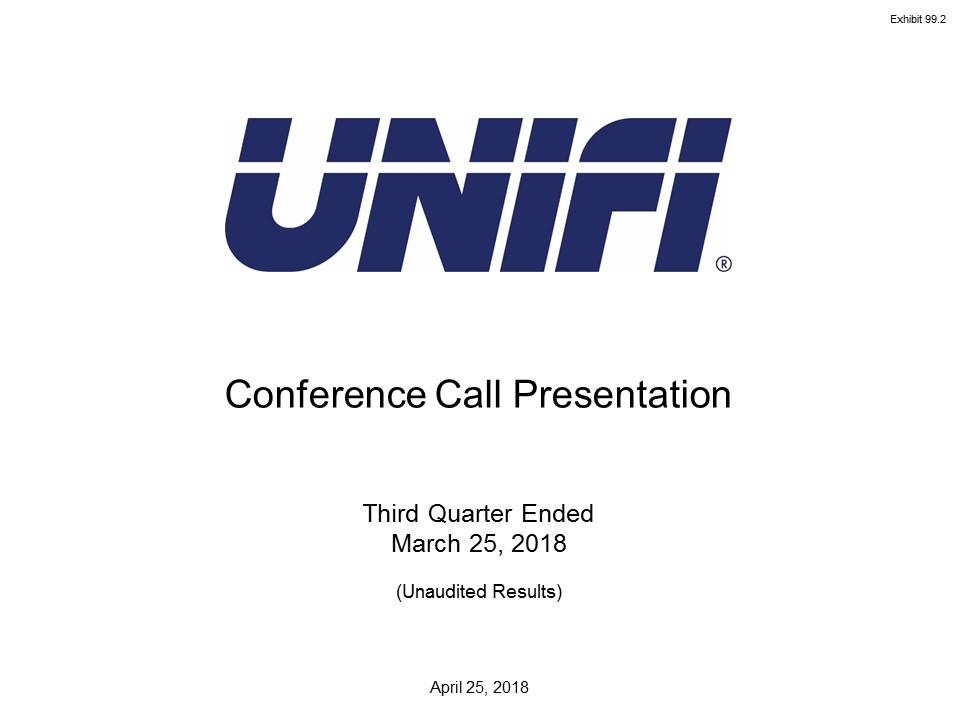
Third Quarter Ended March 25, 2018 (Unaudited Results) Conference Call Presentation April 25, 2018 Exhibit 99.2
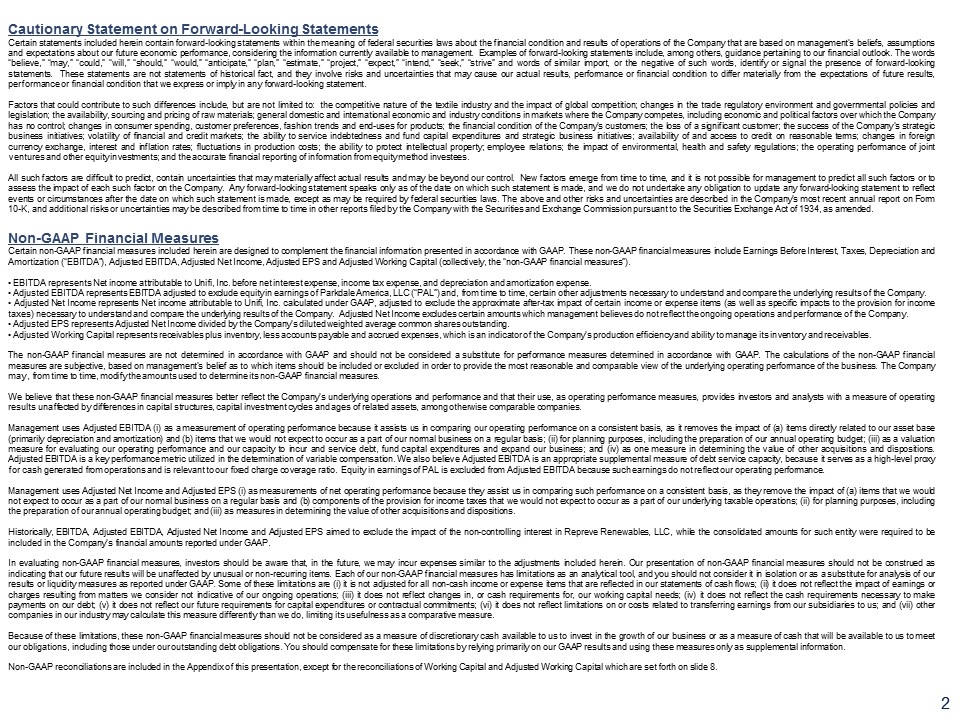
Cautionary Statement on Forward-Looking Statements Certain statements included herein contain forward-looking statements within the meaning of federal securities laws about the financial condition and results of operations of the Company that are based on management’s beliefs, assumptions and expectations about our future economic performance, considering the information currently available to management. Examples of forward-looking statements include, among others, guidance pertaining to our financial outlook. The words “believe,” “may,” “could,” “will,” “should,” “would,” “anticipate,” “plan,” “estimate,” “project,” “expect,” “intend,” “seek,” “strive” and words of similar import, or the negative of such words, identify or signal the presence of forward-looking statements. These statements are not statements of historical fact, and they involve risks and uncertainties that may cause our actual results, performance or financial condition to differ materially from the expectations of future results, performance or financial condition that we express or imply in any forward-looking statement. Factors that could contribute to such differences include, but are not limited to: the competitive nature of the textile industry and the impact of global competition; changes in the trade regulatory environment and governmental policies and legislation; the availability, sourcing and pricing of raw materials; general domestic and international economic and industry conditions in markets where the Company competes, including economic and political factors over which the Company has no control; changes in consumer spending, customer preferences, fashion trends and end-uses for products; the financial condition of the Company’s customers; the loss of a significant customer; the success of the Company’s strategic business initiatives; volatility of financial and credit markets; the ability to service indebtedness and fund capital expenditures and strategic business initiatives; availability of and access to credit on reasonable terms; changes in foreign currency exchange, interest and inflation rates; fluctuations in production costs; the ability to protect intellectual property; employee relations; the impact of environmental, health and safety regulations; the operating performance of joint ventures and other equity investments; and the accurate financial reporting of information from equity method investees. All such factors are difficult to predict, contain uncertainties that may materially affect actual results and may be beyond our control. New factors emerge from time to time, and it is not possible for management to predict all such factors or to assess the impact of each such factor on the Company. Any forward-looking statement speaks only as of the date on which such statement is made, and we do not undertake any obligation to update any forward-looking statement to reflect events or circumstances after the date on which such statement is made, except as may be required by federal securities laws. The above and other risks and uncertainties are described in the Company’s most recent annual report on Form 10-K, and additional risks or uncertainties may be described from time to time in other reports filed by the Company with the Securities and Exchange Commission pursuant to the Securities Exchange Act of 1934, as amended. Non-GAAP Financial Measures Certain non-GAAP financial measures included herein are designed to complement the financial information presented in accordance with GAAP. These non-GAAP financial measures include Earnings Before Interest, Taxes, Depreciation and Amortization (“EBITDA”), Adjusted EBITDA, Adjusted Net Income, Adjusted EPS and Adjusted Working Capital (collectively, the “non-GAAP financial measures”). • EBITDA represents Net income attributable to Unifi, Inc. before net interest expense, income tax expense, and depreciation and amortization expense. • Adjusted EBITDA represents EBITDA adjusted to exclude equity in earnings of Parkdale America, LLC (“PAL”) and, from time to time, certain other adjustments necessary to understand and compare the underlying results of the Company. • Adjusted Net Income represents Net income attributable to Unifi, Inc. calculated under GAAP, adjusted to exclude the approximate after-tax impact of certain income or expense items (as well as specific impacts to the provision for income taxes) necessary to understand and compare the underlying results of the Company. Adjusted Net Income excludes certain amounts which management believes do not reflect the ongoing operations and performance of the Company. • Adjusted EPS represents Adjusted Net Income divided by the Company’s diluted weighted average common shares outstanding. • Adjusted Working Capital represents receivables plus inventory, less accounts payable and accrued expenses, which is an indicator of the Company’s production efficiency and ability to manage its inventory and receivables. The non-GAAP financial measures are not determined in accordance with GAAP and should not be considered a substitute for performance measures determined in accordance with GAAP. The calculations of the non-GAAP financial measures are subjective, based on management’s belief as to which items should be included or excluded in order to provide the most reasonable and comparable view of the underlying operating performance of the business. The Company may, from time to time, modify the amounts used to determine its non-GAAP financial measures. We believe that these non-GAAP financial measures better reflect the Company’s underlying operations and performance and that their use, as operating performance measures, provides investors and analysts with a measure of operating results unaffected by differences in capital structures, capital investment cycles and ages of related assets, among otherwise comparable companies. Management uses Adjusted EBITDA (i) as a measurement of operating performance because it assists us in comparing our operating performance on a consistent basis, as it removes the impact of (a) items directly related to our asset base (primarily depreciation and amortization) and (b) items that we would not expect to occur as a part of our normal business on a regular basis; (ii) for planning purposes, including the preparation of our annual operating budget; (iii) as a valuation measure for evaluating our operating performance and our capacity to incur and service debt, fund capital expenditures and expand our business; and (iv) as one measure in determining the value of other acquisitions and dispositions. Adjusted EBITDA is a key performance metric utilized in the determination of variable compensation. We also believe Adjusted EBITDA is an appropriate supplemental measure of debt service capacity, because it serves as a high-level proxy for cash generated from operations and is relevant to our fixed charge coverage ratio. Equity in earnings of PAL is excluded from Adjusted EBITDA because such earnings do not reflect our operating performance. Management uses Adjusted Net Income and Adjusted EPS (i) as measurements of net operating performance because they assist us in comparing such performance on a consistent basis, as they remove the impact of (a) items that we would not expect to occur as a part of our normal business on a regular basis and (b) components of the provision for income taxes that we would not expect to occur as a part of our underlying taxable operations; (ii) for planning purposes, including the preparation of our annual operating budget; and (iii) as measures in determining the value of other acquisitions and dispositions. Historically, EBITDA, Adjusted EBITDA, Adjusted Net Income and Adjusted EPS aimed to exclude the impact of the non-controlling interest in Repreve Renewables, LLC, while the consolidated amounts for such entity were required to be included in the Company’s financial amounts reported under GAAP. In evaluating non-GAAP financial measures, investors should be aware that, in the future, we may incur expenses similar to the adjustments included herein. Our presentation of non-GAAP financial measures should not be construed as indicating that our future results will be unaffected by unusual or non-recurring items. Each of our non-GAAP financial measures has limitations as an analytical tool, and you should not consider it in isolation or as a substitute for analysis of our results or liquidity measures as reported under GAAP. Some of these limitations are (i) it is not adjusted for all non-cash income or expense items that are reflected in our statements of cash flows; (ii) it does not reflect the impact of earnings or charges resulting from matters we consider not indicative of our ongoing operations; (iii) it does not reflect changes in, or cash requirements for, our working capital needs; (iv) it does not reflect the cash requirements necessary to make payments on our debt; (v) it does not reflect our future requirements for capital expenditures or contractual commitments; (vi) it does not reflect limitations on or costs related to transferring earnings from our subsidiaries to us; and (vii) other companies in our industry may calculate this measure differently than we do, limiting its usefulness as a comparative measure. Because of these limitations, these non-GAAP financial measures should not be considered as a measure of discretionary cash available to us to invest in the growth of our business or as a measure of cash that will be available to us to meet our obligations, including those under our outstanding debt obligations. You should compensate for these limitations by relying primarily on our GAAP results and using these measures only as supplemental information. Non-GAAP reconciliations are included in the Appendix of this presentation, except for the reconciliations of Working Capital and Adjusted Working Capital which are set forth on slide 8.
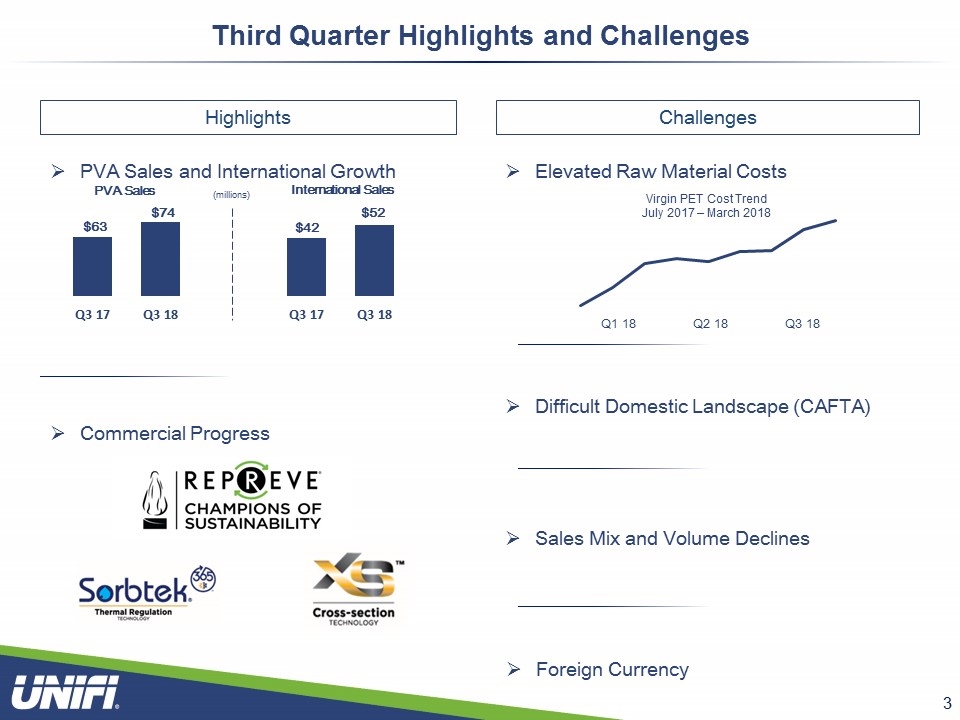
Third Quarter Highlights and Challenges Commercial Progress Highlights Challenges PVA Sales and International Growth Elevated Raw Material Costs Sales Mix and Volume Declines Difficult Domestic Landscape (CAFTA) Foreign Currency PVA Sales International Sales Q1 18 Q2 18 Q3 18 $63 $74 $52 $42 (millions)
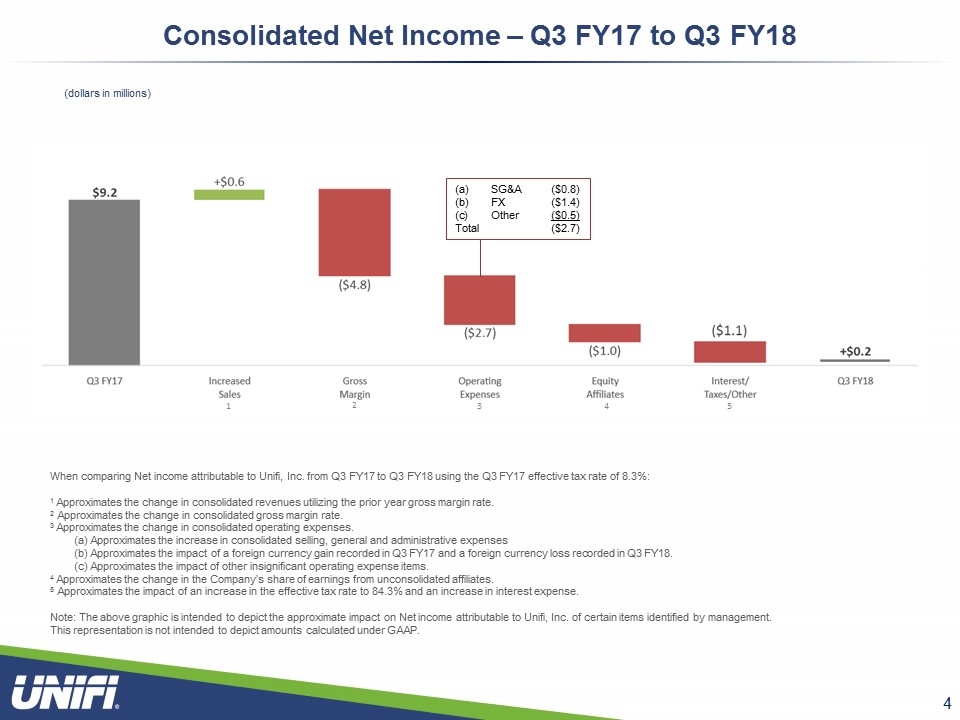
Consolidated Net Income – Q3 FY17 to Q3 FY18 When comparing Net income attributable to Unifi, Inc. from Q3 FY17 to Q3 FY18 using the Q3 FY17 effective tax rate of 8.3%: 1 Approximates the change in consolidated revenues utilizing the prior year gross margin rate. 2 Approximates the change in consolidated gross margin rate. 3 Approximates the change in consolidated operating expenses. (a) Approximates the increase in consolidated selling, general and administrative expenses (b) Approximates the impact of a foreign currency gain recorded in Q3 FY17 and a foreign currency loss recorded in Q3 FY18. (c) Approximates the impact of other insignificant operating expense items. 4 Approximates the change in the Company’s share of earnings from unconsolidated affiliates. 5 Approximates the impact of an increase in the effective tax rate to 84.3% and an increase in interest expense. Note: The above graphic is intended to depict the approximate impact on Net income attributable to Unifi, Inc. of certain items identified by management. This representation is not intended to depict amounts calculated under GAAP. (dollars in millions) 1 2 4 5 3 SG&A($0.8) FX($1.4) Other($0.5) Total($2.7)
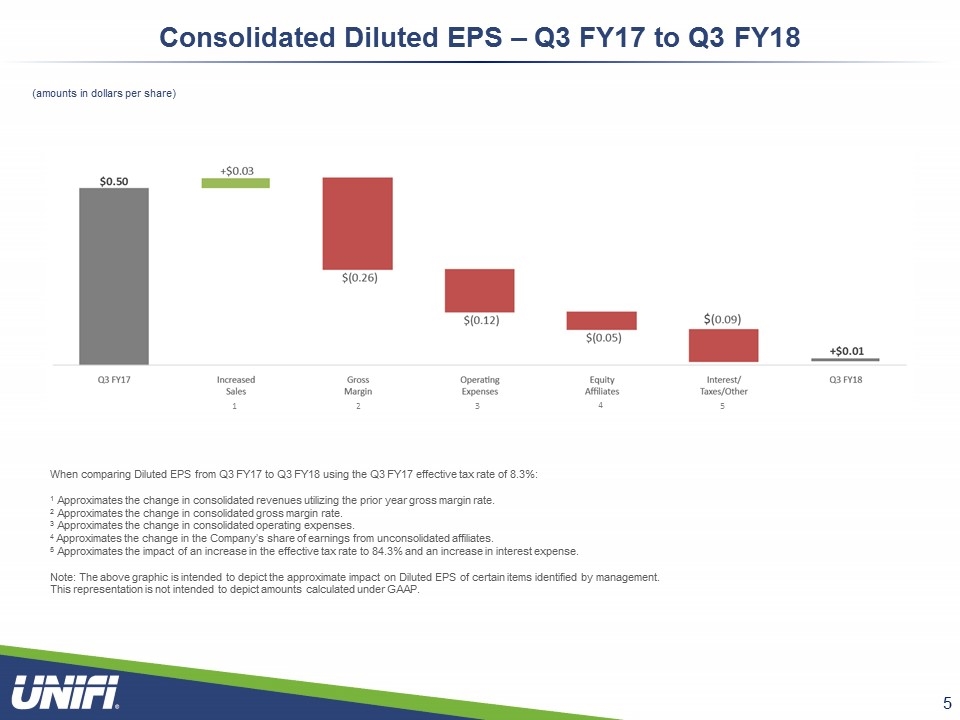
Consolidated Diluted EPS – Q3 FY17 to Q3 FY18 When comparing Diluted EPS from Q3 FY17 to Q3 FY18 using the Q3 FY17 effective tax rate of 8.3%: 1 Approximates the change in consolidated revenues utilizing the prior year gross margin rate. 2 Approximates the change in consolidated gross margin rate. 3 Approximates the change in consolidated operating expenses. 4 Approximates the change in the Company’s share of earnings from unconsolidated affiliates. 5 Approximates the impact of an increase in the effective tax rate to 84.3% and an increase in interest expense. Note: The above graphic is intended to depict the approximate impact on Diluted EPS of certain items identified by management. This representation is not intended to depict amounts calculated under GAAP. (amounts in dollars per share) 1 2 4 5 3
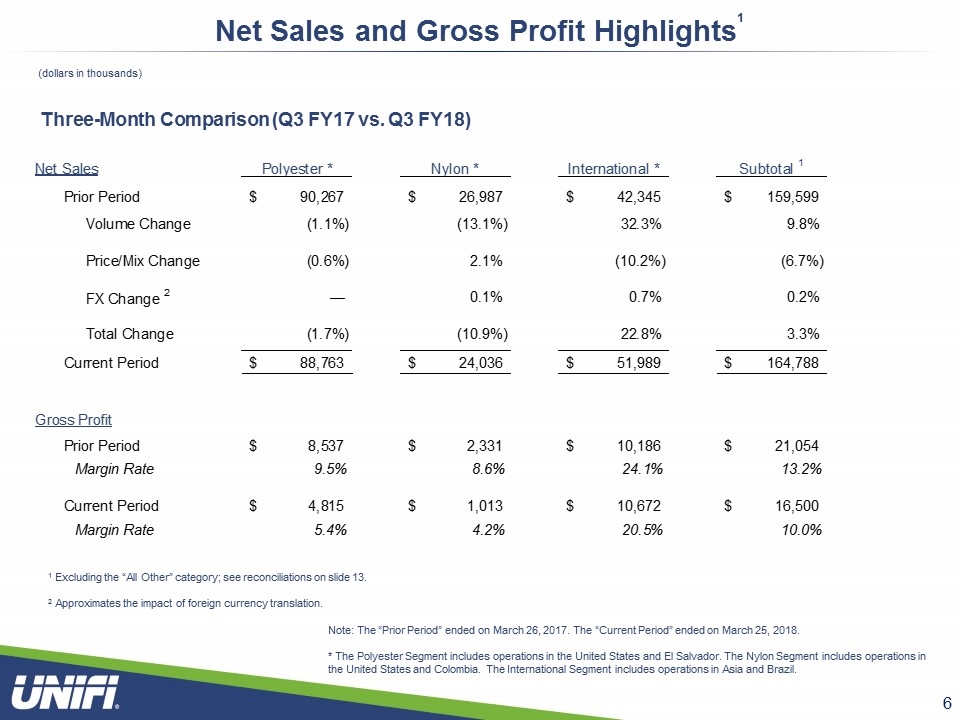
Net Sales and Gross Profit Highlights1 1 Excluding the “All Other” category; see reconciliations on slide 13. 2 Approximates the impact of foreign currency translation. (dollars in thousands) Three-Month Comparison (Q3 FY17 vs. Q3 FY18) Note: The “Prior Period” ended on March 26, 2017. The “Current Period” ended on March 25, 2018. * The Polyester Segment includes operations in the United States and El Salvador. The Nylon Segment includes operations in the United States and Colombia. The International Segment includes operations in Asia and Brazil.
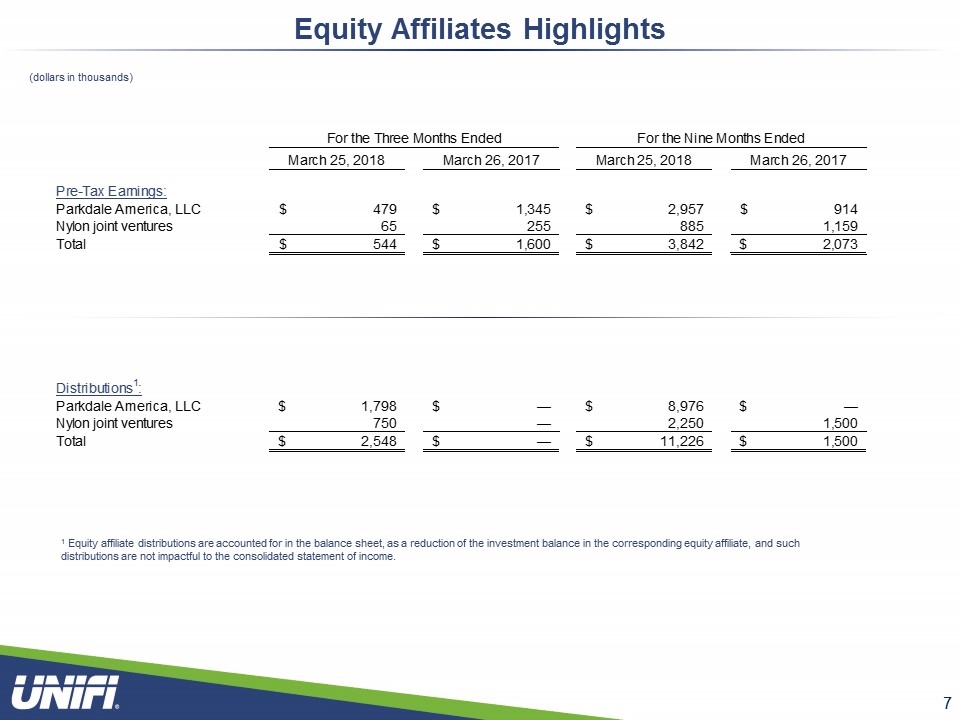
Equity Affiliates Highlights (dollars in thousands) 1 Equity affiliate distributions are accounted for in the balance sheet, as a reduction of the investment balance in the corresponding equity affiliate, and such distributions are not impactful to the consolidated statement of income.
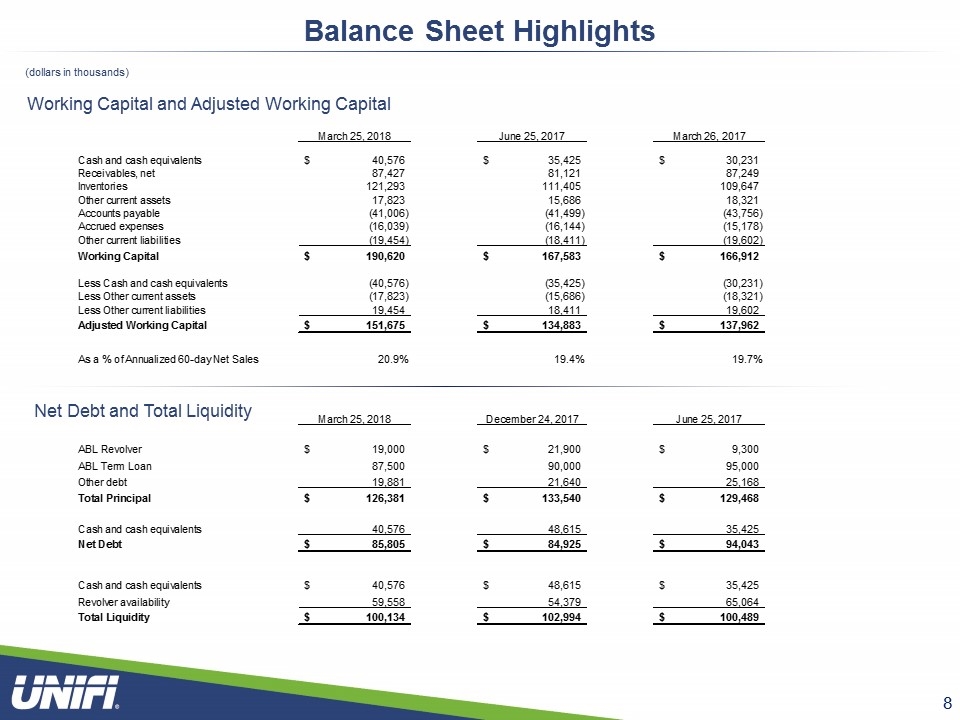
Balance Sheet Highlights Net Debt and Total Liquidity (dollars in thousands) Working Capital and Adjusted Working Capital
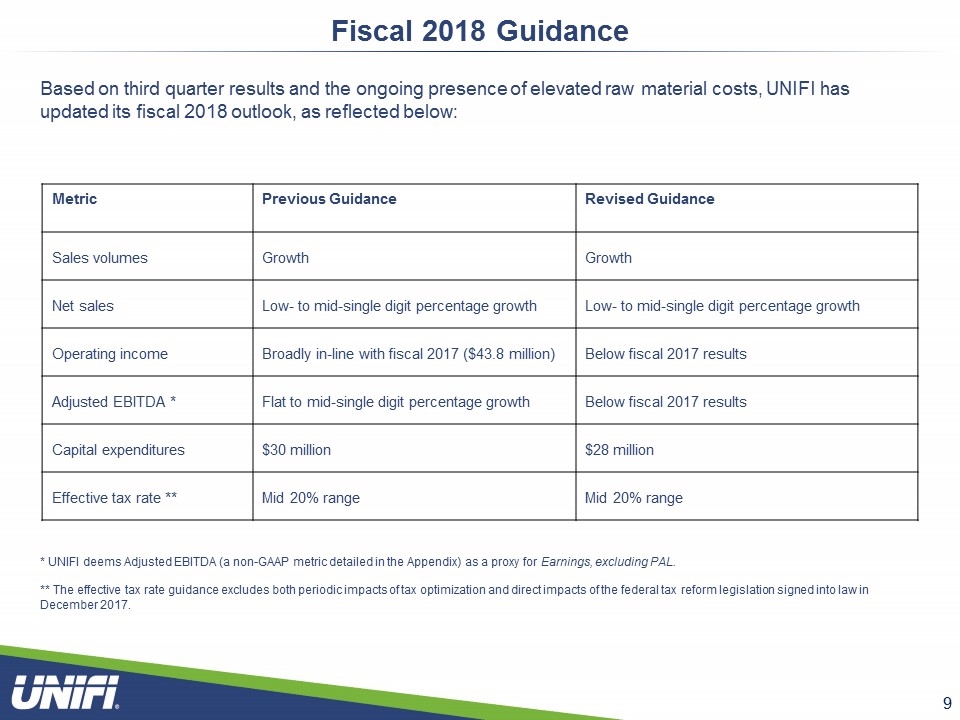
Fiscal 2018 Guidance Based on third quarter results and the ongoing presence of elevated raw material costs, UNIFI has updated its fiscal 2018 outlook, as reflected below: Metric Previous Guidance Revised Guidance Sales volumes Growth Growth Net sales Low- to mid-single digit percentage growth Low- to mid-single digit percentage growth Operating income Broadly in-line with fiscal 2017 ($43.8 million) Below fiscal 2017 results Adjusted EBITDA * Flat to mid-single digit percentage growth Below fiscal 2017 results Capital expenditures $30 million $28 million Effective tax rate ** Mid 20% range Mid 20% range * UNIFI deems Adjusted EBITDA (a non-GAAP metric detailed in the Appendix) as a proxy for Earnings, excluding PAL. ** The effective tax rate guidance excludes both periodic impacts of tax optimization and direct impacts of the federal tax reform legislation signed into law in December 2017.
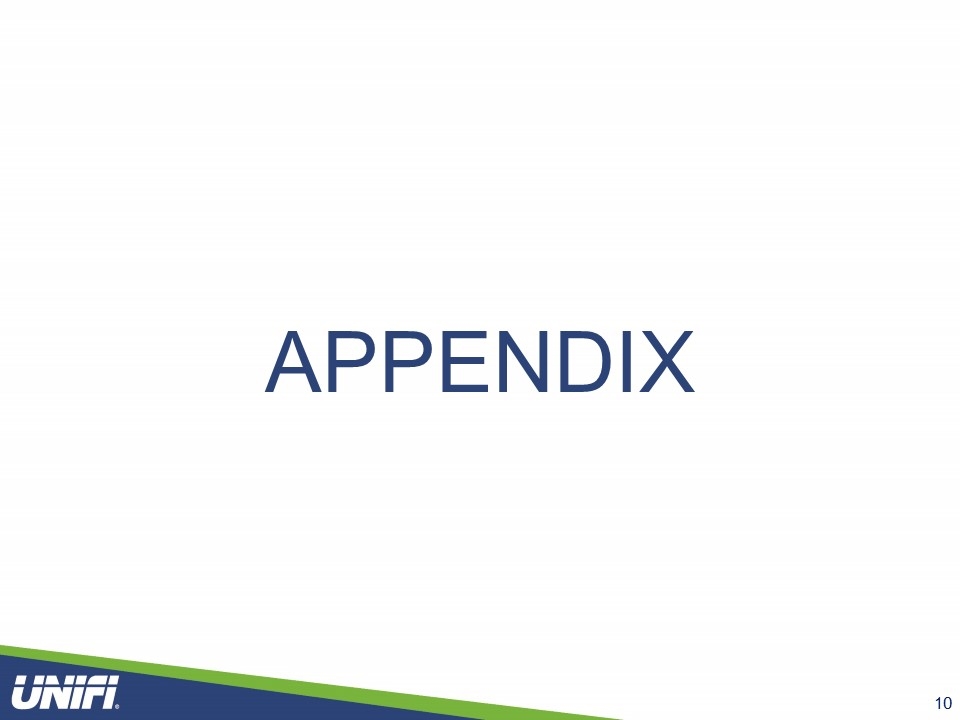
APPENDIX
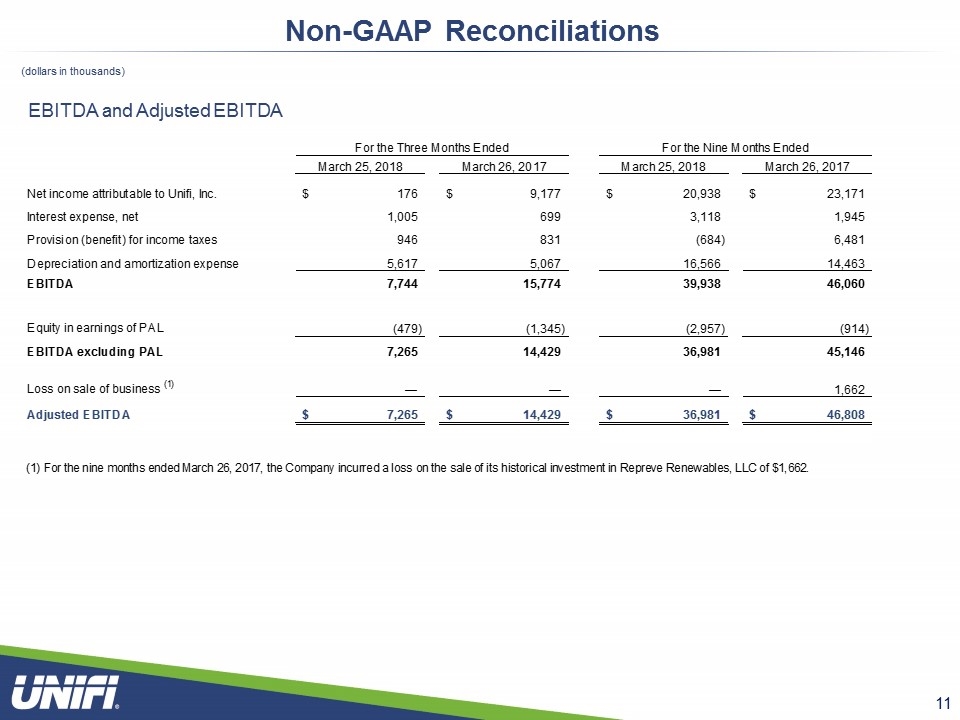
Non-GAAP Reconciliations (dollars in thousands) EBITDA and Adjusted EBITDA
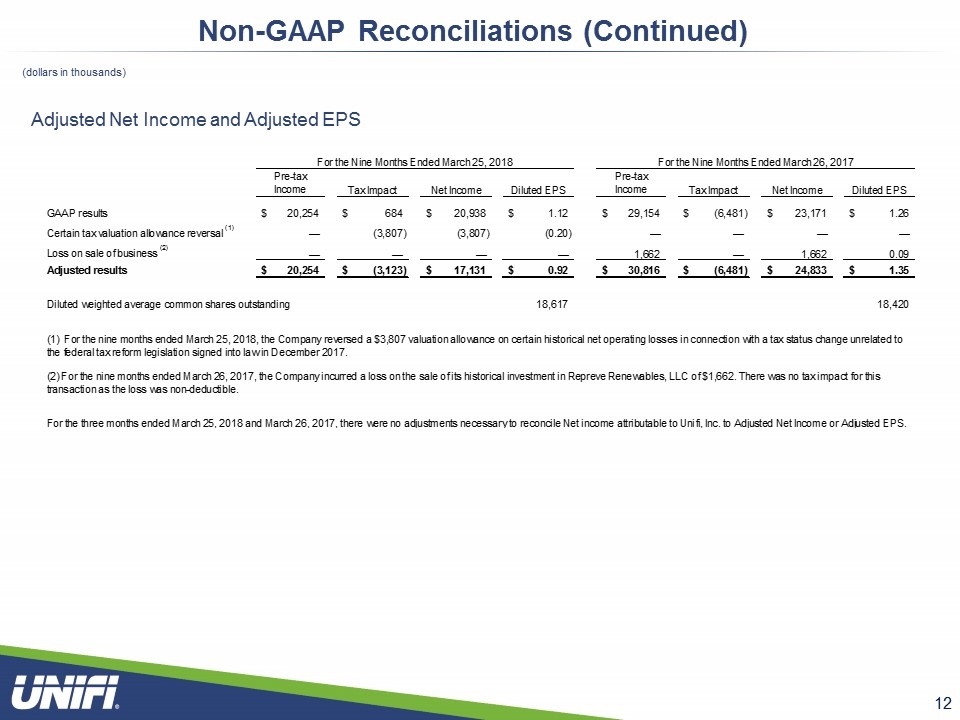
Non-GAAP Reconciliations (Continued) (dollars in thousands) Adjusted Net Income and Adjusted EPS
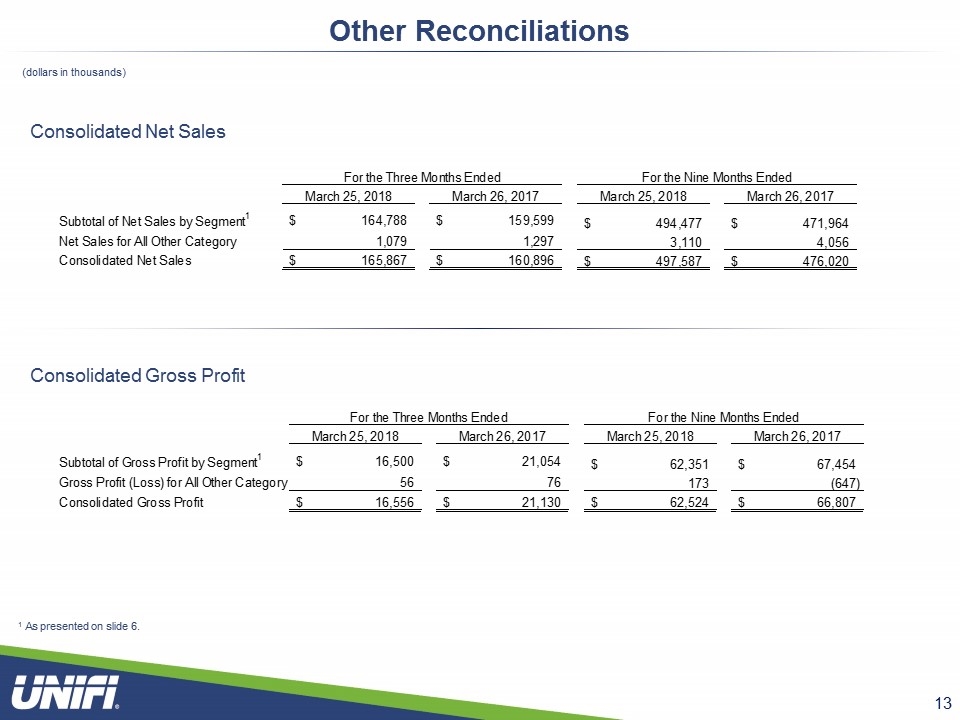
Other Reconciliations (dollars in thousands) Consolidated Net Sales Consolidated Gross Profit 1 As presented on slide 6.

Thank You!
